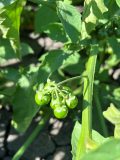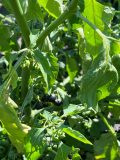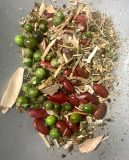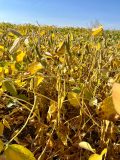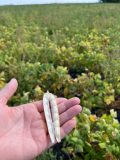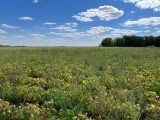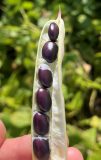 September 21, 2022
September 21, 2022
- Crop and Scouting Update
- Impact of Fall Frost on Soybeans
- Soybean Harvest Tips
- Reducing Soybean Harvest Losses
- Dry Bean Harvest Tips
- Winter Cereals Ahead of Soybeans and Dry Beans
- Canadian Grain Commissions’ (CGC) Harvest Sample Program
- Pulse Canada Farmer Quality Testing Program
- Post-Harvest Storage of Pulses
Crop and Scouting Update
- Soybeans range from R7 (physiological maturity where at least on pod on the main stem has reached its mature colour) to R8 (full maturity where 95% of pods have reached their mature colour) with harvest beginning in the central region of Manitoba.
- Field peas continue to be harvested, with approximately 96% of pea harvest complete.
- Learn more about the pea leaf weevil, a newer pest to Manitoba in this Pulse School video – pea leaf weevil’s range expanding east.
- Dry beans range from R8.5 (mid maturity) to R9 (full maturity) stages. Harvest is underway with good yields reported.
- Watch for nightshades, which produce berries that are soft inside and may stain beans, impacting grading. Find more information here.
Nightshade berries. Source Dan Bolton, Hensall Co-op Maturing nightshade weed with green and ripening berries on September 9, 2022. Green nightshade berries in dark kidney bean sample. Source Dan Bolton, Hensall Co-op - Soybeans are considered an allergen and may be challenging to clean out of certain market classes.
- If noticing either of these difficult weeds in your crop, reach out to your buyer to discuss options and consider binning separately from other fields.
- Faba beans are at R8 (full maturity) and harvest has begun in some areas. Some fields are at R7 (mid maturity) where lower pods have ripened.
Soybean Harvest Tips
- Soybeans are ready for harvest once seed moisture is <14%, around 5-10 days after R8 (full maturity) has been reached. At R8, 95% of pods are brown, all leaves have dropped and seeds rattle within pods.
- Soybeans can be combined when seed moisture is below 20%, but seed must be stored at <14%. Avoid harvesting at <12% seed moisture to prevent cracking and splitting.
- Soybeans may be direct harvested (straight cut) or swathed. Direct harvesting is the preferred method. If swathed, combine shortly after to avoid quality loss. Soybeans are easily damaged by rain if left in the swath.
- Keep harvest speed below 5 mph to minimize header losses. Measure losses regularly during harvest to optimize your combine settings.
- If soybean seed moisture is <11%, harvest when humidity is high to reduce shatter loss and mechanical damage.
Impact of Fall Frost on Soybeans
Soybeans currently range from R7 to R8 and are considered safe from fall frost. If parts of the field are lagging behind at R6 and R6.5 then the impact of frost will depend on the growth stage, severity and duration of the frost and may also be impacted by the following factors:
- Duration of cool temperatures – longer duration of freezing temperatures can cause more damage.
- Soil moisture – moisture in the soil will retain heat.
- Canopy thickness – narrow, thick rows maintain heat longer than wide rows.
- Wind speed – stronger wind can reduce the severity of frost.
- Cloud cover – more nighttime cloud cover can reduce plant damage.
For full details on the percentage of yield loss expected from frost at different development stages, refer to the MPSG bulletin on Soybean Maturity and Low Temperatures.
Reducing Soybean Harvest Losses
Since over 80% of harvest losses occur at the header, it is the focus for capturing yield at harvest time. The Bean App has a tool for calculating harvest yield losses based on lost soybean seed counts – this tool may be used to measure losses at the header or behind the combine.
Tips for reducing header losses:
- Type of header – A draper header, when properly adjusted (i.e., to the bean setting), can reduce yield loss by 0.5-1 bu/ac compared to an auger header.
- Angle setting of the header – Spend the time adjusting the header angle settings between crops to minimize losses, regardless of the header type. Getting the knife positioned between the ground and lower tip of the bottom pod is key.
- Use of an air system – Losses can be reduced by 0.5-1 bu/ac, on average, when using an air system on either a draper or auger header. At a price of $10/bu, this can provide a savings of $5-10/ac. To determine if an air system is worth the investment, consider that the payback area for an air system with an average capital cost of $16,500 would be 1,650-3,300 acres. This indicates that using an air system can provide substantial benefit in reducing losses.
- Ground speed – The effect of ground speed needs to be weighed against the urgency of harvest. Combine speeds of 3-4 mph reduce losses compared to higher speeds of 5-7 mph (average difference of 0.5 bu/ac).
Dry Bean Harvest Tips
Dry beans can be harvested by undercutting and windrowing, swathing or straight combining. Undercutting is typical for row-cropped beans and vine-type varieties that pod low to the ground. Straight combining or swathing is more common for solid-seeded beans and bush-type varieties with higher pods. Straight combining also requires flat soil that has not been inter-row cultivated.
Dry beans are ready for harvest when:
- All leaves have dropped
- All pods have changed colour
- 75% of pods are dry and the remaining pods may be flexible and yellow with seeds that have fully changed colour (R9 stage)
- Seed moisture is 16-18%
Check out the Edible Bean School: Prepping the combine for harvest
Tips for maintaining seed quality:
SOIL INTAKE AND SMEARING
- To reduce soil intake, 1) place screen kits at the header and under the feeder house, 2) windrow beans that have been undercut to remove soil that is clinging to the roots and/or 3) increase fan speed if the soil is dry.
- Soft, puffy immature beans will dry down normally in the bin, but they need to be free of earth tag so that they are not smeared with soil and counted later as damaged seed. Waiting for these puffy beans to dry down naturally can result in a drier than desired sample, so following the above tactics to keep soil from entering the hopper and using a conveyor mounted on the combine to unload can help reduce smearing.
SPLITS AND CRACKS
- To minimize splits and cracks (checking the sample periodically and aiming for <10%), 1) reduce cylinder speed by 100 rpm intervals until you see a noticeable difference, 2) close the concave if cylinder speed adjustments don’t make a difference, 3) use a bean (or wide wire) concave that allows beans to flow through the concave faster, 4) create larger windrows or straight-combine a wider width to keep more material flowing into the combine, which helps cushion the beans, and 5) harvest when plants are dry, so pods open more easily.
- Dry beans are often stored and traded at 17% seed moisture, but 16% is considered dry. If seeds are dried to less than 16% moisture, there is a greater risk of split seed coats and cracked or shriveled beans. If seed moisture rises above 18%, there is an increased risk of heating and spoilage.
Adapted from the Pulse Beat article Harvesting Tips to Improve Dry Bean Quality.
Fall Rye Ahead of Soybeans and Dry Beans
Fall rye may be successfully used as a cover crop ahead of beans to protect soil from erosion, manage soil moisture, suppress weeds and draw down residual nitrate levels.
Soybeans
According to NDSU research, rye planted earlier in the fall (late September to early October) at seeding rates of 50 to 75 lbs/ac had increased ground cover and weed suppression, while providing an environment the next spring that achieved satisfactory soybean yield that was no different from the control without the rye cover crop. Recent MB research evaluated termination timing of the fall rye cover crop in the spring. In this experiment, soybean yield was not different among the control, plots terminated 14 days before planting, terminated 4 days before planting or terminated 1 day after planting. To conserve moisture, terminate the rye earlier in the spring, to use more moisture, let it grow longer.
Dry Beans
As dry beans are typically planted in late May to early June, there is a greater opportunity to capitalize on the soil protection benefits of having a winter cereal as a cover crop. NDSU research has also evaluated fall rye ahead of pinto beans. In their research, fall rye as a cover crop ahead of pinto beans provided weed suppression and soil protection benefits, while dry bean yield potential was maintained. However, termination of the rye must be timed carefully during dry conditions to maintain yield potential. Averaged over four years (2017-2020), terminating rye 2.5 to 5 weeks before planting achieved the greatest yields.

For more information, check out this resource: Growing rye as a cover crop – NDSU
On-Farm Network Update
The On-Farm Network (OFN) values curiosity. A high level of curiosity and questioning is considered a healthy trait here at the OFN and acts as fuel for innovative research ideas. While spending time in the combine this harvest, get curious about this past season and how it played out. What did you notice in your fields? Which practices would you like to try next year? Were those extra dollars spent on fungicide, increased seeding rates or fertilizers economical in the end? Which questions went unanswered?
Harvest is far from over but it’s never too soon to think about the next season. If you’ve got a question, the OFN can help you answer it. Reach out to Leanne at 204-751-0439 or leanne@manitobapulse.ca to set up a trial in 2023, or get inspired by past trials showcased in the comprehensive database. Have a safe and productive harvest!
Canadian Grain Commissions’ (CGC) Harvest Sample Program
The CGC offers a free unofficial grade to samples submitted in their program. To participate you sign up here to receive a harvest sample kit for assessment. Results can be used when marketing and delivering your grain. Mail your samples following harvest with the pre-paid envelopes.
Quality results include:
- Unofficial grade
- Protein content on barley, beans, chickpeas, lentils, oats, peas and wheat
- Dockage assessment on canola
- Oil, protein and chlorophyll content for canola
- Oil and protein content and iodine value for flaxseed
- Oil and protein for mustard seed and soybeans
- Falling number for wheat and rye
- Vomitoxin (deoxynivalenol or DON) levels for wheat, corn and barley
The CGC accepts new participants until October 29 and samples can be submitted up until November 30. Results are available within 20 days.
Pulse Canada Farmer Quality Testing Program
Are you considering or did you use glyphosate as a preharvest tool this year?
Pulse Canada has developed a Farmer Quality Testing Program to provide free, confidential residue testing for farmers and agronomists to ensure the proper application timing of preharvest glyphosate for pulse crops. The results of the program will allow farmers to further ensure the effective application of pre-harvest glyphosate and maintain the world-class quality of Canadian pulses. Peas, lentils, chickpeas and faba beans qualify. Interested in this opportunity? Check it out here.

